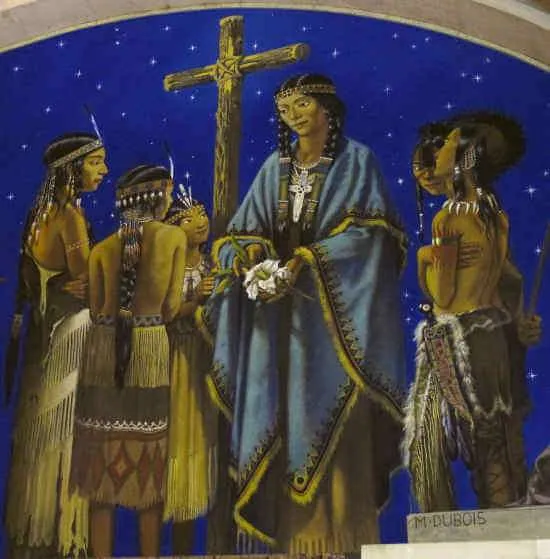1656–1680; Patron Saint of Canada, Native Americans, ecologists, environment, exiles, orphans, people ridiculed for their piety, and the physically impaired; Canonized by Pope Benedict XVI on October 21, 2012
Jesuit missionaries arrived in modern-day Canada in 1625. By 1636, Saint Isaac Jogues and his companions made their way to present-day Auriesville, New York. After being captured and imprisoned by the Mohawks, they escaped but courageously returned to continue sharing the Gospel. They were martyred the following year, in 1646. Ten years later, in the area of their martyrdom, Saint Kateri Tekakwitha was born. There is little doubt that the blood spilt by these first North American martyrs helped to fuel the faith of this first Native American saint.
Tekakwitha was her given Mohawk name as a child, a name which might mean “she who bumps into things.” This could be due to the fact that she had poor eyesight and felt her way around. Alternatively, her name might also mean, “she who puts things into order.” Her mother was a Christian from the Algonquin tribe who had been taken captive and later forced to marry a Mohawk chief when her village was raided by the Mohawks. The couple had two children, Tekakwitha and her younger brother. When Tekakwitha was four years old, smallpox ravaged her village, taking the lives of her parents and baby brother. The disease left Tekakwitha’s face scarred and her vision blurred, making it difficult to see in sunlight. After her parents’ death, her aunt and uncle adopted her.
Though Tekakwitha was never baptized by her Christian mother, she did learn about the Catholic faith and embraced it from an early age. Perhaps her mother’s premature death prompted her to cherish the lessons she learned from her as a young child. Her aunt and uncle, however, were not Christian, and they encouraged her to abandon her beliefs. Tekakwitha’s daily life consisted of chores and playtime with other girls. She worked in fields of corn, beans, and squash; picked roots in the forest used for medicines and dye; gathered firewood; and became proficient at working with beads and basket weaving. She also spent long periods of time alone in the woods where she practiced her faith, reflecting and praying the best she could, given her limited Christian formation.
When Tekakwitha was around the age of thirteen, in accord with tribal custom, her uncle arranged for her to be married to a young man her age. When told of her engagement, she refused it. “I have consecrated myself entirely to Jesus, the Son of Mary, and He alone I have chosen as a husband, and He alone will take me for a wife.”
Around this time, the French settlers entered into a peace treaty with the Mohawk. As a result, Jesuits were permitted to enter the settlement and begin sharing the faith. One day, Tekakwitha met Father Jacques de Lamberville and announced to him, “My name is Tekakwitha and I wish to become a Christian.” Around the age of eighteen, Tekakwitha became a catechumen and diligently studied the Catholic faith. On Easter Sunday, 1676, at the age of twenty, she was baptized and took the name Catherine, Kateri in Mohawk, after Saint Catherine of Siena.
After her baptism, Kateri was persecuted and ridiculed by others within her settlement. Because she would not work on Sundays, she was refused food on those days. Children taunted her and threw rocks at her in response to their parents’ criticism. She was even threatened with torture and death. One year after Kateri’s baptism, Father de Lamberville encouraged her to secretly move 200 miles north to their Catholic settlement near Montreal, the Mission of Saint Francis Xavier. He sent with her a letter to those at the mission in which he stated, “Guard well this treasure and you will soon discover the jewel that I have sent you.” It took Kateri two months to travel through forests to reach the mission. Once she arrived, her evident devotion resulted in permission to make her First Holy Communion earlier than most converts, which took place on Christmas Day of that same year, surrounded by other faithful Catholics.
For the next two and a half years, Kateri embraced her faith with profound devotion. She attended Mass daily, often twice a day, and spent most of her free time in the chapel, praying on her knees. She entered into deep trances, and her spirit would be snatched up to Heaven for a time. When this happened, the countenance of her face would become lovely to behold. She not only prayed profoundly, she also inflicted severe penances upon herself, grew in virtue, was known for her exceptional kindness, and loved praying the rosary, which she wore around her neck. She often made crosses out of sticks and placed them in the forest so she would be reminded to pray every time she came upon one. Her personal motto was, “Who can tell me what is most pleasing to God that I may do it?” Though she could not read or write, she memorized many Bible stories and would tell others those stories with great delight and inspiration.
On March 25, 1679, with the assistance of her spiritual director, Kateri made a private vow of perpetual virginity. She had wanted to found a religious order for native girls but was prohibited from doing so because of her poor health. One year later, after her health continued to deteriorate, she died at the age of twenty-four. She had spent four years as a baptized Christian and one year as a consecrated virgin. As soon as she died, the scars on her face disappeared, and God made her face as beautiful as her soul. Word of her death spread rapidly from village to village, all across New France (Canada) and even to the Royal Court. “The saint has died!” they said. Everyone knew who the “saint” was. After her death, many miracles took place, especially for those who prayed at her tomb, including many deep conversions.
Saint Kateri Tekakwitha has been given the affectionate name, “Lily of the Mohawks.” A lily is a symbol of purity, which Kateri manifested in her life. Lilies bloom only for a short time, just as her life was short. Though her life was largely hidden, her virtues, prayer life, and deep union with God were on display for all to see. She stood out for her wholehearted determination to please God in everything she did. Not only did she inspire other natives in her settlement, she even deeply inspired the Jesuit priests who ministered to her. It was they who wrote and told her story.
As we honor Saint Kateri today, ponder the calling God gives to us all to become pure and holy, and to radiate that purity of heart in such a way that others take note. Allow Saint Kateri to inspire you to follow her example, and try to embrace her motto as your own, “Who can tell me what is most pleasing to God that I may do it?”
Source: https://mycatholic.life/saints/saints-of-the-liturgical-year/july-14—saint-kateri-tekakwitha-virgin—usa-memorial/








